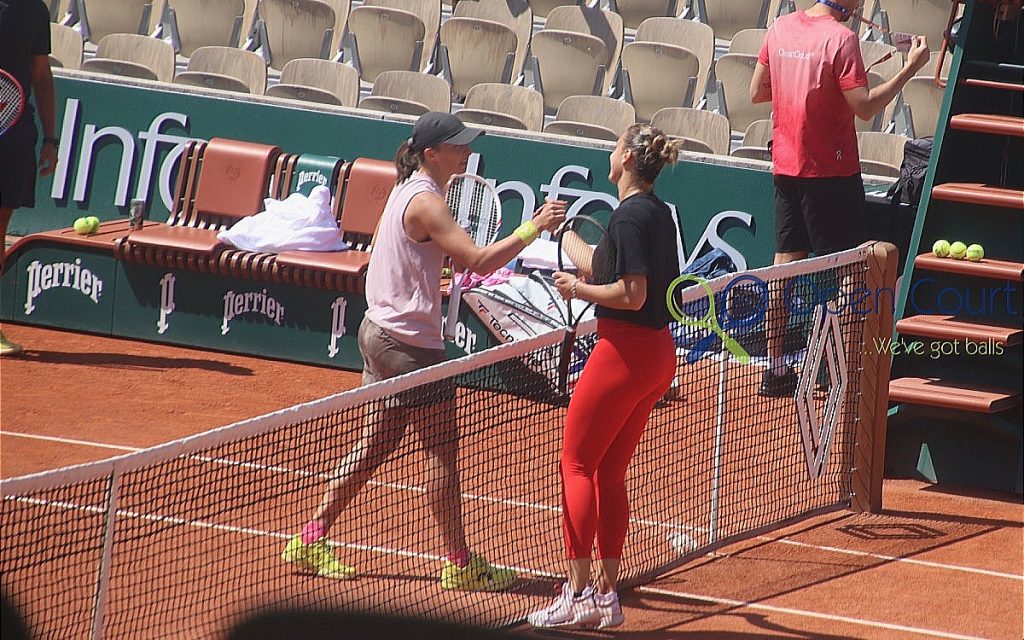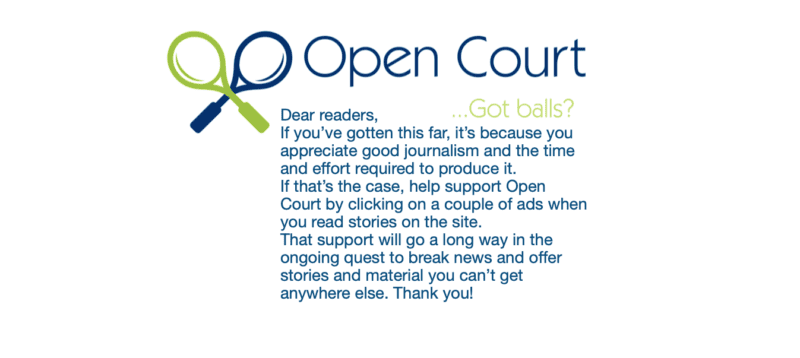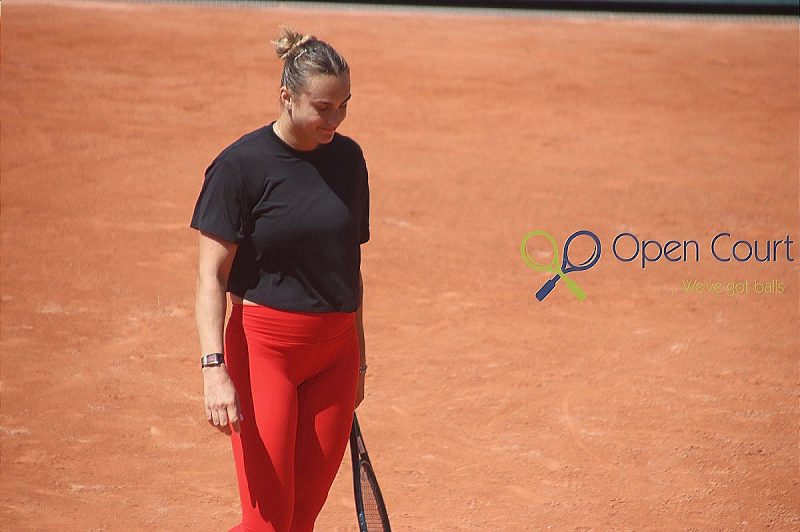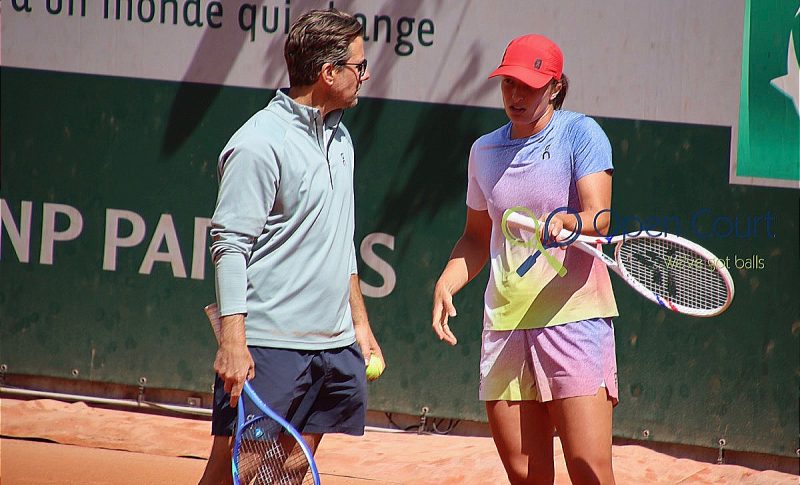
–
ROLAND GARROS – A fortnight ago, four-time Roland Garros champion Iga Swiatek and world No. 1 Aryna Sabalenka practiced together in a locked-up Court Simonne-Mathieu ahead of this year’s event.
(That many of the fans on hand for the qualifying would have loved to see this, and couldn’t even get past Court 2 before being blocked, is a topic for another day).
Even the written press couldn’t get in to observe this top-level practice session, which might have offered a few clues about how these two star players might approach their 13th meeting on Thursday.
Here’s what it looked like – through the keyhole, so to speak.
“It’s great always to practice with Aryna. She gives a great rhythm, and the practice will have quality, you know, so it was great,” Swiatek said of that hit, which she said wasn’t a “real practice” as much as just playing points. “Honestly, it was like two weeks ago. It was the first points that I played after Rome. I think a lot changed since then.”
For Sabalenka, the practice was emblematic of the fact that, well, perhaps both have matured and are more confident in their stature. It’s always a tricky thing with the top women to practice with each other – for reasons that could spawn a post of their own. But they’re getting there.

“I mean, before it wasn’t any communication, any practices with her, but now we are getting better. We get along better, and we practice more often, and we know each other quite well,” Sabalenka said. “I think everything started when I just came to her and asked to do TikTok in the Finals in Riyadh. Since that, we were, like, ‘Okay, maybe we can communicate, we can be good to each other, we can practice sometimes,” she added. smiling. “So I think that was, like, the first step to a better relationship.”
This time it’s the semifinals of Roland Garros, a tournament Swiatek has won four times including the last three years. But she comes in on a season that by her lofty standards has been a bit subpar.
Time to step up for Sabalenka
For Sabalenka, it’s a watershed moment. She hasn’t yet won a major off of hard courts. And her last two Roland Garros quests ended in crushing disappointments: 7-5 in the third set to Karolina Muchova in the 2023 semifinals, and 6-4 in the third last year to Mirra Andreeva in the quarterfinals.
She has inarguably been the most consistent player of late in the women’s game – something that would have been nigh-on unthinkable just a couple of years ago. And her winning percentage on clay is just barely below what it is on hard courts.
Her power game can work on any surface. And she’s slowly but surely adding other elements to her game, finally grasping how changing pace and trajectory can be so effective on a Tour full of players used to constant pace.
She comes into this semifinal 17-2 during this clay-court season.

Head-to-head favors Swiatek
Sabalenka won just four times in 12 previous matches against Swiatek. Somewhat surprisingly, half of those meetings have been on clay.
And most of those clashes have been in particular circumstances on clay – conditions that you would think would favor Sabalenka more than they would otherwise.
They’ve played twice in Stuttgart – indoor clay-court conditions, rather quick and with less clay than outdoor courts. Those came in back-to-back finals in 2022 and 2023, and Swiatek won both in straight sets. That said, the “curse of the Porsche” is real for the Belarussian in Stuttgart.
The two also met in back-to-back finals at the Madrid Open in 2023 and 2024. Again – a bit of altitude, faster, good conditions for a power player like Sabalenka.
Those two clashes produced two of the best finals on the WTA Tour in recent memory. Sabalenka’s only clay victory over Swiatek was a 6-3, 3-6, 6-3 win in the 2023 final. A year ago, Swiatek won – 9-7 in the third set tiebreak.
The other two matches came in Rome, the tournament that’s arguably most similar to Roland Garros in terms of conditions. Those, Swiatek won rather routinely.
The fact that the conditions are dank, cool and humid for Thursday’s semifinal, you have to think, only helps Swiatek. It will be slower, harder to hit winners. And Swiatek’s defence is leagues ahead of that of her opponent. The conditions mean she will get even more balls back, perhaps force Sabalenka to go for more to try to finish off points (a strategy that usually means more errors, too).
A year of adaptation for Swiatek
A wise tennis legend once said that if you’re not getting better in tennis, you’re falling behind because everyone else is.
And for Swiatek, that might have been the impetus behind hiring “super-coach” Wim Fissette to help her take those next steps.
The respect comes from the fact that there’s big picture thinking there; the doubt comes from wondering how a player SO programmed into her routines, her tactics, her entire tennis being can let go of some of the things that have made her great, to reach an even higher level in the long term.
An underrated factor here that rarely seems to get mentioned is that this is the first time in Swiatek’s pro career that she’s not being coached in her native Polish. Rather, it’s a Belgian communicating with a Pole in what is, at the very least, their second language.
This is a big thing; someone speaking reasonably good English in a tennis context does not mean fluency. Not even close. It’s a huge leap from learning, absorbing information in your own language, and adding that intermediate step where you have to translate it in your head before trying to put it in practice. It requires completely rewiring your learning processes.
As well, it’s extra difficult for a player who can say to herself, “Hey, I got to No. 1 doing exactly what I’ve been doing. And now you want me to change major things in my game?” There’s an understandable, if unintentional, resistance to chance in someone who has already accomplished so much. And that’s another barrier Swiatek has had to burst through.
You could see a small sign of her resisting it a bit less in her match against Elena Rybakina, who was all over her in the first set.
Swiatek’s mindset has been to hug the baseline as much as possible on serve returns. But through the course of that match, she gradually dropped back a bit to get a better look at Rybakina’s big first serve. It paid big dividends.
“Yeah, I mean, I’ve been practicing that a little bit. Wim, it was his plan to kind of convince me sometimes to try it out, but I never really thought that – I wasn’t sure if that’s my thing, you know, because I remember a few years back, when I started being more aggressive, I started winning more,” she said after that match.

“I think girls are serving faster now, and everybody is developing. There are some limits to what you can react to. I think the coaching actually really helped me today, because I wouldn’t come up with this myself. Even though I practice it a little bit, it’s still like a weird thing for me to do.”
The fact that it worked on this day greatly helped, of course. If she had tried it, and it hadn’t worked, Swiatek would have been in “I told you so” mode.
It has felt, this year, that Fissette was on somewhat of a razor’s edge because a medium-term plan wasn’t paying short-term dividends. And we’ve seen how so many players are no longer waiting until the end of the season to assess coaches and make changes. It’s open season, all season.
But Swiatek has played her way back to confidence during this Roland Garros.

The two have met just once at a major – and that meeting was nearly three years ago, in the semifinals of the US Open.
Can Swiatek take it another step against Sabalenka? The prospect of meeting Coco Gauff (whom she pretty much owns on clay) or unseeded Cinderella Loïs Boisson in the final on Saturday has to make you think this is the de facto women’s final.
Or will the Belarussian break through the barrier and reach a Roland Garros final for the first time?
Should be fascinating.
More Stories
WTA Rankings Report – As of Oct. 6, 2025
Canucks This Week – Week ending Oct. 12, 2025 (Thursday results)
ATP Rankings Report – As of Sept. 29, 2025